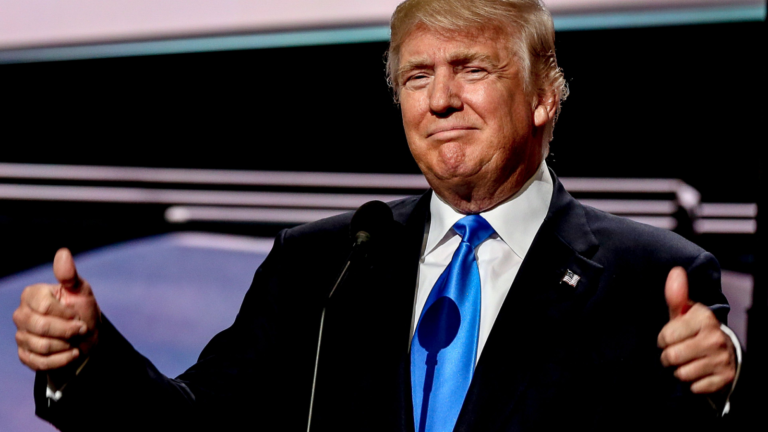Everyone knows that former President Donald Trump is a big fan of tariffs. In fact, they formed a cornerstone of his economic agenda. During his presidency, Trump implemented severe tariffs, including on steel and aluminum, that ultimately resulted in the U.S.-China trade war. This policy failure caused significant strife for both his own economy and China’s. The Brookings Institute concluded that these tariffs “significantly hurt the American economy without solving the underlying economic concerns that the trade war was meant to resolve.”
But Trump doesn’t seem to have learned from his mistakes.
Instead, he’s focused on doubling down on tariffs if he is reelected in November. This time he has even bigger plans, which promise to further devastate the U.S. economy if implemented.
Trump Tariffs: 2018 vs. 2024
How are Trump’s plans now different from what he implemented the first time around?
In March 2018, Trump announced that the U.S would impose 25% and 10% tariffs on imported steel and aluminum, respectively. Over the course of his first term he also levied tariffs on solar panels, washing machines, and a host of other imported goods from China and other trading partners such as Canada and Mexico.
If reelected, he wants to impose a 10% tariff on all imported products and increase the current tariff on Chinese imports to 60%. Trump even told TIME that he may impose higher tariffs than 10% and 60%. In recent days, he has gone so far as to suggest that an “all tariff” policy could replace federal income tax in the U.S.
Trump’s goal with these tariffs is to “protect American jobs as well as raise more revenue to offset an extension of his 2017 tax cuts.” With the Tax Cuts and Jobs Act (TCJA) breaks currently set to expire in 2025, Trump has touted that in a second term, he would extend all of its provisions. The Congressional Budget Office believes doing so would add $4.6 trillion to the national deficit over a 10-year period… so revenue to make up for that would have to come from somewhere.
Plus, tariffs on imported goods could incentivize more American-based manufacturing and improve the business outcomes of American industrial firms as typically cheaper foreign goods become more expensive.
But will further tariffs really help keep Americans employed? Data shows that the first U.S.-China trade war cost the U.S. 245,000 jobs before Trump left office. Whereas the Bureau of Labor Statistics reports that in May 2023 alone, 272,000 new jobs were created under President Joe Biden while unemployment remained under 4%.
Instead of helping employment, Trump’s proposed tariffs could make things even worse.
“Even if Trump used the tariff revenue to fund tax cuts, his proposals for a 10% tariffs on imports and a 60% tariff on Chinese goods would cost the US economy 675,000 jobs, wipe out 0.6 percentage points from US gross domestic product (the broadest measure of the economy) and boost the unemployment rate by 0.4 percentage points, according to Moody’s projections shared first with CNN,” Matt Egan wrote for CNN.
While Trump acknowledged that most economists argue that tariffs raise consumer prices, he also told TIME that he disagrees. Instead of leading to inflation, he believes higher tariffs would lower costs that American firms and consumers pay for goods.
But that doesn’t seem likely. In fact, I have previously reported that Trump’s proposed all-encompassing 10% tariff would almost certainly lead to higher inflation.
Why It Matters
Investors should pay careful attention to Egan’s analysis of Trump’s touted tariffs and their potential negative impact. As the writer notes, even if Trump can successfully raise the necessary revenue to fund his planned tax cuts, working Americans will end up shouldering the cost. Experts suggest that middle-income households would face extra costs of $1,700 each year.
If new tariffs pass more costs onto Americans, the average consumer will have less spending power. If consumers have less money to spend while the prices of many goods continue rising, the economy as a whole will suffer.
This sharp decrease in consumer spending would mean fewer sales, leading to lower corporate profits and worse earnings reports. While this is bad news for the overall market, it would be particularly detrimental for companies that deal in nonessential products and services. For instance, by the end of 2019, U.S. investment growth had already fallen 0.3 percentage points as a direct result of the trade war.
If investors aren’t yet wary of the next one, they should be.
On the date of publication, Samuel O’Brient did not have (either directly or indirectly) any positions in the securities mentioned in this article. The opinions expressed in this article are those of the writer, subject to the InvestorPlace.com Publishing Guidelines.

